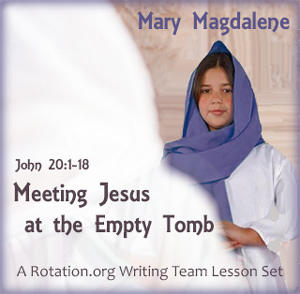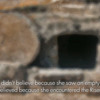Rotation.org Writing Team
Mary Magdalene: Meeting Jesus at the Empty Tomb
Lesson Set Objectives and Bible Background

Scripture
Bible Story: John 20:1-18
Key/Memory Verse
“Mary Magdalene went and announced to the disciples, ‘I have seen the Lord’, and she told them that he had said these things to her.” John 20:18 (NRSV)
Lesson Objectives
- Teach John's version of the Empty Tomb story into memory, helping students understand how John's version differs from other Gospel stories of the empty tomb.
- Place ourselves at the Empty Tomb and understand how Mary's encounter with the risen Christ is similar to our own --that it can be unexpected, personal, and life-changing.
- Consider ways we are called to respond to the good news that "He is risen."
- Rescue Mary Magdalene's reputation from the misrepresentations that evolved over the centuries in the Church and media, and restore her to her rightful place as a dear disciple of Jesus who was honored to be the first person to whom Jesus appeared at his resurrection.
Bible Background
What does Mary Magdalene's story mean?
John's version of the Empty Tomb story is unique, and like so many other things in John, it points to a deeper meaning and reality which younger children may find hard to grasp. Thus, our first task is to teach the story so that it can unfold its meaning as they grow.
Mary went to the Tomb in grief and returned with faith. How did that happen? It happened because Jesus speaks his resurrected presence to us. Like every single one of us, at first Mary Magdalene didn't recognize Jesus, and even when she did according to John, she wasn't allowed to physically touch him (for a reason beyond our comprehension). And yet the encounter was so real that it changed her life and compelled her to share the amazing news with others. This is the life-changing presence we too hope to experience or have already experienced. And yes, to some extent we can prepare to encounter the Risen Jesus, and all the confirming encounters to come.
- Mary was acquainted with his voice; are you?
- Mary went to the cross and tomb; have you?
- Mary turned when she heard him call and reached out to embrace him; how are you doing that?
- And Mary taught others to look for him, believe, and continue his mission. How can you do that?
Who was Mary from Magdala?
- Most significantly, she was a beloved friend and faithful follower of Jesus,
- She is the only person mentioned at the Empty Tomb in all four Gospels.
- According to John, she was the first person to whom Jesus appeared after the resurrection.
- According to John, she was the first to share the Good News of Jesus' resurrection —earning her the title, “Apostle to the Apostles.”
The word “Magdalene” tells us that Mary was from the village of Magdala, a community on the western shore of the Sea of Galilee, near Capernaum. The fact that she is named in this way, instead of referencing a husband's name, may indicate that she had never married or perhaps her husband had died. This village is not far from Capernaum, so it is also possible that she had family ties to one of the male disciples, or perhaps Jesus himself.
Both Luke and Mark tell us that Mary was healed, presumably by Jesus, of seven demons --which we today understand may reference a host of medical conditions. The Gospels tell us that she was part of the group of women who followed Jesus from Galilee and that they “provided for” Jesus and the disciples “out of their resources” (Matthew 27:55-56, Mark 15:41, Luke 8:2-3). These other women included Jesus' mother, Mary the wife of Cleopas, Joanna, and perhaps others. Though often portrayed as a younger woman, we simply don't know how old she was, and she may have been an older woman given that it did not raise eyebrows that she was in the company of men.
Interestingly, Mary Magdalene is not mentioned in the Book of Acts, but then neither are several other Disciples. Did she pass away? Travel to spread the word? Or was she just a victim of the male-centric tendencies of Early Church writings? Writing some 40 years later in the Book of Acts, Luke does write about another woman, Lydia, but does not relate the fate of Jesus' mother or the women so prominently described in his gospel. We are left to assume, that like Paul and many others mentioned in scripture, we simply do not know what happened to them.
What was her role?
Mary was one of the earliest followers of Jesus, and one of several women who often traveled with the disciples, learning from him, and likely taking care of the group's daily needs and acting as an extension of Jesus' care for others. Mary was there in Jerusalem for the last days, and thus it is likely that she helped prepare, serve, and clean up the Last Supper, and perhaps participate it in. Only Mary Magdalene is present at the Empty Tomb in all four Gospels, which is surely a confirmation of her importance among the group, her faith in Jesus, and Jesus' faith in her.
In John, the male Disciples did not see Jesus at the Empty Tomb. That honor was reserved for Mary Magdalene. The significance of Jesus bestowing such an honor on a woman in that day and age cannot be understated and is in keeping with Jesus' vision of a new Kingdom where the old attitudes and ideas of worth no longer apply.
The Story in brief according to John
- Mary Magdalene goes to the tomb, sees the stone rolled away, and then runs to tell Peter and John.
- Mary returns with Peter and John who see the rolled up linens and then leave.
- In her grief, Mary stays behind, and then suddenly sees two angels sitting inside the tomb.
- The angels ask her why she is crying, and she replies that they have "taken her master."
- She turns around and Jesus asks her why she is crying -but she thinks he's the gardener!
- Mary asks the gardener where they have taken him.
- Jesus says to her, “Mary!” and she replies, "Teacher!"
- Jesus immediately tells her do not touch me, go and tell the others.
- Mary returns to the disciples and says, "I have seen the Lord."
Note that John is the only Empty Tomb account that includes male disciples at the tomb, but they do not encounter Jesus until the upper room.
The Other Gospels
Matthew 28:1-10
Two women: Mary Magdalene and the "other" Mary. No men. There's an earthquake, an angel sitting on the rolled-away stone, and terrified guards. The angel says, "Do not be afraid, for I know that you are looking for Jesus, who was crucified. He is not here; he has risen, just as he said. Come and see the place where he lay. Then go quickly and tell his disciples." Jesus speaks to the women as they are leaving.
Mark 16:1-8
Three women: Mary Magdalene, and Mary the mother of James, and Salome (who actually may be the same person as Mary the mother of James). No men. The stone is rolled away. A young man wearing white is in the tomb. He says, "He has risen; He is not here; behold, here is the place where they laid Him. Go tell his disciples."
Luke 24:1-10
Three women: Mary Magdalene, Mary the mother of James, and Joanna. No men. The stone is rolled away when they arrive. They enter the tomb and suddenly two angels appear. "Why do you seek the living among the dead? He is risen." The women leave to report to the male disciples.
It's a common misconception that Mary the Mother of Jesus was one of the Mary's at the empty tomb. Three of the Gospels mention "Mary the mother of James" ...also known as "the other Mary." This is James the disciple, the "Son of Zebedee," and not Jesus' brother James of later prominence. This other Mary may be the wife of Clopas (Cleopas) of Emmaus Road fame. Interestingly, in John 20:2, Mary says "we do not know where they have laid him," though the rest of the story emphasizes it was just Mary M. present.
Why are the accounts so different?
People have been debating this question since the 1st Century. Time, distance and memory can do strange things to verbal accounts, especially in a pre-technological age. It is likely that Matthew, Luke, and John were not acquainted with each other's gospels. But they all agree on these things: Mary Magdalene was there, messenger(s) from God were present, the tomb was empty, and the good news had to be shared.
What does it matter to us as teachers?
Students will eventually hear the different gospel accounts and may be confused. It's not helpful to homogenize what God has preserved as unique accounts. Each tells us something different about the nature of the Resurrection and how we might experience Christ, and they remind us that the Gospels are not histories in the conventional sense, but a joyful truth to be pondered.
What does it matter to us as students?
The risen Jesus appeared many times after the Empty Tomb was discovered, and he still "appears" to be alive to many today. Furthermore, the empty tomb was not proof to Mary or to Peter. It was the presence of the Risen Christ which rekindled their faith. Thus the question can be asked:
- Has he appeared to you? And How does he "appear"?
- Do you believe it?
- What does it mean that Jesus is alive? ...to you, to the world?
- And what are you going to do about this wonderful news?
(See more discussion questions below.)
If the Bible accounts don't agree on the "facts" does this mean these are just "stories"?
A dead body rising from the grave is beyond the idea of "facts" and history as we commonly think of them. And the empty tomb itself was not the "fact" which engendered faith in anyone. Mary saw the emptiness and still thought they had stolen his body. The reality and message of the empty tomb only becomes a "fact" when we experience the Risen Christ and choose to believe.
Rescuing Mary of Magdala from a False Reputation
Centuries of salacious and misleading Church innuendo and artwork about Mary Magdalene have finally come unraveled. Modern Biblical scholarship and a purging of past anti-female bias in interpretation have restored Mary Magdalene's deserved reputation. There was a time when some in The Church portrayed her as a prostitute. Unfortunate teachers supposed her to be the fallen woman Jesus saved from stoning, or the woman who washed Jesus' feet with her hair --without a shred of evidence from the Bible itself. In fact, the only reference to her past is that she had been cured by Jesus of "seven demons" (and we know today that "demon" can mean illness). Luke, who uses Mark as a source, repeats that story, but given that Mark’s reference is vague and second-hand, the only thing we can say for sure about her past is that Jesus healed her, welcomed her discipleship, and specifically spoke to her at the Empty Tomb.
Resurrection Theology
We cannot teach this story without teaching the meaning of Christ's resurrection. Short of writing a library of words, we can say this:
- The Resurrection of Jesus is God's confirmation of Jesus' identity and authority as the Son of God.
- The Resurrection confirms Jesus' teachings, especially those about of the Kingdom, and continues the transformational work of the Kingdom.
- The Resurrection of Jesus invites us to look, listen, and expect the Risen Christ in our own life. And to be ready to respond with faith and sharing to promote his Kingdom.
- The Resurrection of Jesus tells us that our own "tombs" can be opened, that God can roll away the stone that's keeping us buried in trouble and grief.
- The Resurrection of Jesus tells us that physical death is not the end for us either.
- The Resurrection of Jesus teaches us that we can begin to experience the life-changing joy of resurrection starting today.
Mary's experience at the Empty Tomb as a guide to our own
- We can share Mary's love for Christ by seeking Jesus. Have you walked with him, and gone to the cross and tomb?
- We can recognize that our grief and confusion (and a whole host of other problems) can keep us from seeing the Risen Lord.
- We can identify and hear the messengers he sent to the tomb and still sends to us today.
- We can seek to know his voice and respond to it when he calls our name.
- Without expecting his physical presence, we can learn to embrace him with our hearts and service.
A Few Questions for Children
- If you had been with Mary Magdalene at the tomb, what would you have said to comfort her in her grief?
- What questions would you have asked Jesus if you had seen him there at the empty tomb? (You can ask him these questions today, by the way!)
- What are you doing to learn more about Jesus so that you will recognize his presence and the sound of his voice when he reveals his presence in your life?
- What was Jesus raised to do?
- In what ways, people, things, places, and experiences does Jesus speak and act to and through us today?
- How are you "announcing" the good news to others of Jesus' living and life-changing presence?
Written by Anne Camp and Neil MacQueen for the Rotation.org Writing Team
Copyright, Rotation.org Inc.





